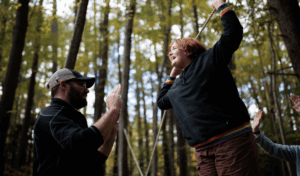Anxiety can simply be defined as “an individual’s response to real or perceived danger.” In general, this response is normal, healthy and adaptive, yet for those with an anxiety disorder, “safe” would be the last word used to describe the feeling of being anxious. This article covers factors that contribute to the development of unhealthy anxiety and describes current treatment modalities.
Prevalence
The National Institute of Mental Health (NIMH) estimates that the lifetime prevalence rate for an anxiety disorder among 13 – 18 year olds is 25.1%. NIMH further estimates that 5.9% of these cases are labeled as “severe.” Additionally, NIMH cites that only about 32 percent of children diagnosed with an anxiety disorder age 8 – 15 sought out professional treatment. Clearly, anxiety is an emerging health issue for teens and youth and one that may not be receiving proper treatment.
Pathological Anxiety
Pathological anxiety is excessive anxiety in the absence of a real life threatening event. This includes anxiety disorders like Social Anxiety Disorder (SAD), Social Phobia (SP), Generalized Anxiety Disorder (GAD) and Panic Disorder. This also includes conditions including Post-Traumatic Stress Disorder (PTSD), Obsessive-Compulsive Disorder (OCD), Body Dysmorphic Disorder (BDD), and Somatic Disorders /Illness Anxiety Disorder. Individuals with an anxiety disorder experience an excessive anxiety response on a physiological and cognitive level which then drives pathological behavior such as avoidance, isolation and social withdrawal or defiance/resistance. The anxiety response is largely driven by the sympathetic nervous system which can also be thought of as the body’s “Fight, Flight, or Freeze” response.
Certain physiological changes occur in order for the body to prepare to face a dangerous situation (fight), run away from danger (flight) or hide/avoid (freeze). Individuals with an anxiety disorder become sensitized to these sensations and experience them as distressing and dangerous. In some individuals, these sensations become an anxiety trigger themselves which can lead to escalating anxiety. This can result in episodes labeled as “panic attacks.”
Cognitively, pathological anxiety is experienced as excessive doubt, fear and worry. Many individuals with anxiety describe their thoughts as “racing” or overwhelming and find themselves endlessly analyzing past mistakes or future catastrophes. Individuals with pathological anxiety believe that their fears are founded and that the feared items, situations, thoughts, memories or sensations really are in fact dangerous. Individuals with anxiety disorders often have problematic beliefs regarding anxiety itself such as “If my anxiety does not go away, I will go crazy,” or “I can’t let anyone see me when I am anxious because I will be irreversibly negatively judged.” Unhealthy anxiety is a result of a combination of overestimating the danger inherent in a situation and underestimating one’s ability to cope with the situation.
Factors contributing to anxiety among teens
The etiology of pathological anxiety is complex. Many individuals have a genetic vulnerability which causes the body’s anxiety response system to activate too intensely and too easily at the perception of danger. In cases of clinical anxiety, this perception is based on faulty beliefs. There are several proposed pathways to the development of these unhealthy behaviors.
Classical conditioning involves the association of a response with a previously neutral stimulus. For example, a child who felt humiliated by a teacher who chided him/her for not turning in homework may not only feel anxious around that teacher in the future but also may feel anxious simply walking into the school building. The building, which was previously neutral, has become associated with danger (humiliation by teachers) and will now evoke a conditioned anxious response. Vicarious learning involves learning to be anxious through another’s experience. A child who watches a friend faint and become injured by hitting his or her head on the ground may become anxious about fainting even though she or has never fainted his or herself. Informational Transmission involves being told by others that certain objects or situations are dangerous. This is common in children and adolescents who themselves have anxious parents. Anxiety disorders seem to have a genetic component and it is common for anxious children to be raised in an “anxious family.”
Cognitive Behavioral Therapy
Cognitive Behavioral Therapy (CBT) focuses on correcting problematic beliefs and interpretations and eliminating behaviors that prevent behavioral change. This is achieved through the use of cognitive restructuring techniques and Exposure and Response Prevention therapy (ERP).
ERP therapy is the process of helping an individual experience a fear trigger while eliminating the use of behaviors that prevent the individual from fully facing the feared stimulus. These behaviors are referred to as “safety behaviors” and include avoidance, OCD rituals, reassurance seeking or defiance. During therapy, individuals create a subjective scale, referred to as Subjective Units of Distress (SUDS). Throughout the exposure process, individuals rate and scale their anxiety level. The reduction of intensity of anxiety symptoms over time is referred to as “habituation.” Traditionally, ERP therapists were taught to aim for a reduction of SUDS to half the level of the peak anxiety experienced to achieve within-session habituation. An exposure task is repeated until the feared stimulus no longer elicits an unmanageable level of anxiety.
Some therapists are hesitant to use exposure therapy due to concerns that a client’s anxiety level will not be able to habituate within the time frame of the session. However, emerging research suggests that within-session habituation is not necessary for corrective learning of problematic beliefs to occur. Exposures should be designed in a way to test anxious predictions in order for clients to experience that their “worst case” scenario does not occur or if it does that it is not as scary or dangerous as they believe it to be. The goal of an exposure is not solely to achieve habituation, but to also create new adaptive learning which then competes with and inhibits the older fear based learning. This inhibitory learning decreases the anxiety aroused by a situation and contributes to an increase in self-confidence and self-efficacy.
Some individuals may be so affected by their anxiety that they are unable or unwilling to participate in ERP therapy. In these cases, residential treatment in a facility experienced in facilitating ERP therapy may help these individuals become “unstuck” and reclaim their lives from anxiety. Residential treatment can provide the opportunity to capture exposure therapy moments present in everyday life which in turn enhances treatment compliance and positive outcomes.
Acceptance and Commitment Therapy
The shift in thinking in ERP therapy from a focus on habituation to one of fear tolerance is similar to another type of treatment used for anxiety called Acceptance and Commitment Therapy (ACT). Sometimes referred to as a “third-wave” in therapeutic modalities, ACT is part of a movement that focuses on accepting difficult thoughts and feelings rather than seeking to fundamentally change them. This is done through identifying personal values and then committing to act in a way that may cause distress in order to live these values and achieve desired goals.
Family Therapy
In the context of anxiety treatment, family accommodation refers to changes made in order to help a family member manage their anxiety. Accommodations that prevent an individual from facing the source of their anxiety reinforce and maintain pathological anxiety. These changes often result from a lack of anxiety psychoeducation within the family and from difficulties tolerating the anxious individual’s distress. Family therapy for anxiety focuses on changing patterns of accommodation and helping the entire family develop tools for managing the increase in distress caused by changing these patterns. When residential treatment is utilized for adolescent or young adults with anxiety, it is crucial that treatment focuses on addressing family patterns as well. This will allow the entire family to function in a healthier way through making decisions that are based on what is best for the family and not ones driven by anxious thinking.
Medication
Medication can be an important part of anxiety treatment. Is it recommended that anxious individuals seek out the guidance of a trained psychiatrist and that medication be used in conjunction with psychotherapy.
Hope
Individuals with an anxiety disorder often live a life controlled by fear. This fear can make seeking out or being compliant with treatment difficult. Anxious teens and adolescents who are unable or unwilling to participate in treatment may need residential treatment in order to engage in therapy in a safe, structured and supportive environment. The supportive environment of a residential treatment center often yields positive results for many of these teens. Although anxiety may be a rising issue in today’s society, with the proper care and treatment, anxious individuals are able to gain the skills and tools they need to live happy, healthy and productive lives.
Author:
Bryan Randolph MS, LICSW
Therapist
Mountain Valley Treatment Center


